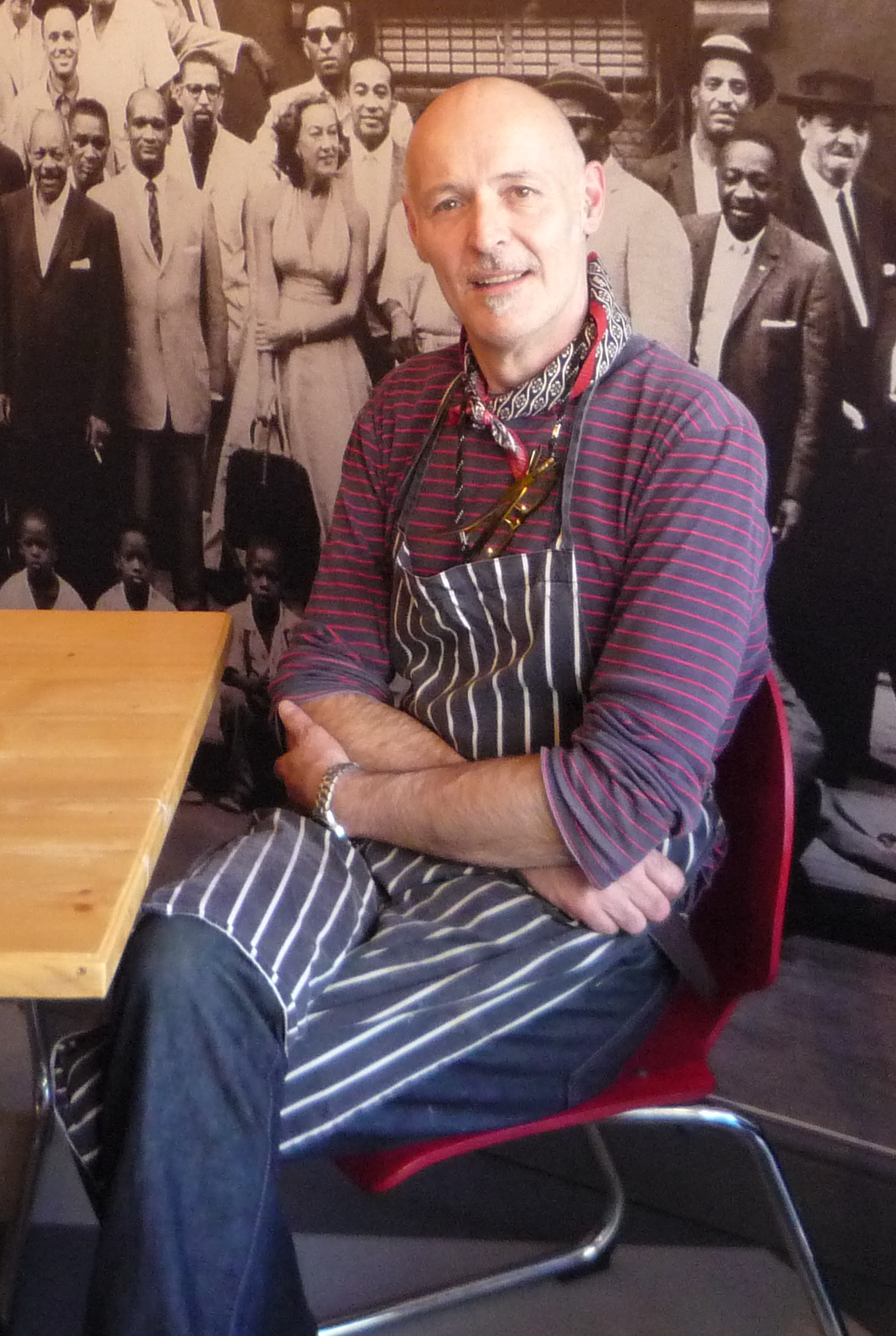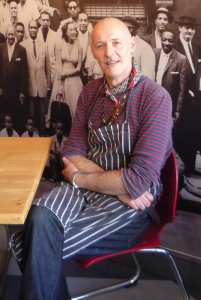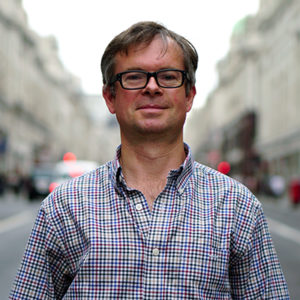John Easterby Interview

SJM editor Charlie Anderson sat down with John Easterby to talk about food, photography and jazz.
With a long and distinguished career in the photographic industry, John Easterby has recently taken on the job of chef at The Verdict cafe in Brighton. I started our conversation by asking him how it all started.
“I did a degree in photography, film and television when I was 18, 19 at The London College of Printing, as it was then called. And then I had a career working as a picture editor. When I started, I was part of the team that opened the first Magnum Photos office in London back in the early Eighties. I was the Archive Director there. I was the custodian of one of the greatest collections of modern reportage photography in the world. My first job out of college. Magnum is the most famous collective of photojournalists in the world. It was started by Cartier-Bresson, Robert Capa, George Rodger, David Seymour. They were responsible for reporting on all the main international events from the Spanish Civil War onwards. As long as Magnum covered it, I’ve got an extraordinary knowledge of modern history, but it’s all utterly dependent on whether they sent a photographer to that event. I did that for ten years. I loved every minute of it.”
“Then, I was given the opportunity to open my own agency doing similar things to Magnum but with British-based photographers. The Independent Photographers Group, which I ran for 15 years. Photographers such as Tom Stoddart, Alastair Thain, David Modell, shooting, much like Magnum, world events.”
“I had a chance to move away away from looking after an archive, all be it a great archive, to working in the front line, I guess, in researching and sending photographers to cover the main stories of the day. For instance, Tom Stoddart, one of my key photographers, documented the siege of Sarajevo for the five plus years of the war. Others were going to various famine zones in Africa.
We specialised in stories that took a long view at any given news event. We weren’t doing spot news, although we were there at the beginning of a lot of stories, but we were the photographers that tended to stay on after the press corp had disappeared to the next ‘shooting match’. We looked at the aftermath and the people who were ‘caught in the crossfire’. It was a very serious, very successful agency for a while. We won multiple awards at the very highest levels. It was a dream for me.”
“And then there was a company called Getty Images reared its head. Getty Images and Corbis. Two kind of asset-stripping, extremely wealthy organisations who decided they wanted to corner and dominate the picture market, which they duly did. And they did so by paying photographers to leave their existing agencies and giving them joining fees and incentives.”
“And IPG, my agency, was one of the agencies that suffered from that process. My key photographers were lured away by offers that I couldn’t match and we ended up going through a whole process of rather aggressive takeover bids until eventually….The writing was on the wall and I realised there was no future and we couldn’t really compete.The whole marketplace had been decimated by these two very powerful and cynical organisations. They drove down their prices because they were in control of the market. They drove down their prices so that it became very difficult for organisations such as my own to survive. And once they’d cornered the market (very much like how a drug dealer operates) they had their clients eating out of their hand and then they started to increase their fees. That was the end of an era for me, working with agencies. I chose to move on. I spent some time producing outdoor exhibitions for well-known photographers such as Tom Stoddart and doing exhibitions for organisations such as Oxfam.”
“Then I was invited to become course leader on the MA in Photojournalism at the London College of Communication, which is the same college I went to as an 18 year old, and I’ve been doing that for the last five years with a varying degree of satisfaction. There were some issues that I wasn’t happy with, most importantly, I felt increasingly uncomfortable taking ever greater sums of money from young, optimistic photographers who wanted to make it in an industry that, I could see, simply couldn’t support that quantity of people coming through a programme, such as my own, each year. I became thoroughly disenchanted with the whole principle of what I was doing and, to a certain extent, slightly disenchanted with the effectiveness of photojournalism over the last thirty years and more that I’ve been involved with it.”
“I was extremely idealistic, as were many of my counterparts, photographers and people in the editorial world, and felt that photography was an incredibly powerful device for mainly bringing about change. But latterly I’ve come to the conclusion that it really isn’t that powerful. It’s maybe bitter and twisted of me, but I think that it actually fulfills a need that many of us have to see and feel a little pang of guilt or conscience, to see difficult situations, but is essentially entertainment. People like the Sunday Times magazine which kind of pretends to be concerned about issues around the world. They don’t, in my view, actually use photojournalism as a campaigning, mind-changing genre. They use it because it’s a little bit cool and it makes their magazine, which is otherwise full of trivia and celebrity-based lifestyle nonsense. It gives it a little bit of a sharper edge but it doesn’t actually really achieve very much.”
“With an ever-growing sense of disenchantment, I was looking for other things. And I happened one night to walk into this place [The Verdict]. I was going to see my good friend Riley Stone-Lonergan play sax with Dave Drake’s band and I’d never been here before. I tried to order some food and everyone looked rather worried, there wasn’t any food and as I talked to Andy (the owner) I realised that the catering side of the club had been a thorn in his side for some time – a real problem.”
“Catering is something that has always been very close to my heart. I trained, before going to university, I started training as a chef in Paris at the Intercontinental Hotel where I was taking time out, hiding from A level results, and it felt like unfinished business. I really always wanted to be involved in some way in cooking and making people happy through food and coffee and things like that. So I offered my services for free. Worked for a month, free of charge, to see if I could actually deliver and whether I enjoyed it. I did and I’m here and I’ve never been happier. I still think that photography is going to be a huge, big part of my life. And I want to keep connections with Brighton University. They have a fantastic photography department. I want what takes place here to be properly photographed, the club in particular.”
“I came here a jazz virgin, really. I came here with no knowledge of jazz at all, apart from the absolutely blindingly obvious – I’d listened to some Miles Davis and I’d been to a few pubs where jazz was playing. It was just a certain kind of music in the background.”
John was keen to talk about the gigs that he had been to recently at The Verdict. “Eddie Myer, who I thought was absolutely amazing, was original, fresh and funky. It was cool. He is one hell of a dude. He’s brilliant. The best that I’ve ever seen here, in terms of it’s freshness, originality and it’s groove. It was groovy. That’s the kind of thing I like. It felt utterly new and it was more melodic than a lot of music that I hear. I came here a jazz virgin, really. I came here with no knowledge of jazz at all, apart from the absolutely blindingly obvious – I’d listened to some Miles Davis and I’d been to a few pubs where jazz was playing. It was just a certain kind of music in the background.”
“Jazz. It’s a joy. I’m really enjoying the process of learning about it. Notwithstanding the fact that my contract with Andy demands that I have jazz playing at all times, I’ve genuinely seen and enjoyed some ‘jazz moments’ as Andy calls them. Here, at The Verdict, downstairs listening to some unbelievable music. If I’m brutally honest, the whole Dave Drake thing for me was absolutely mind blowing. To see a guy that was still at school, producing his own composed work and playing with such virtuosity and with such a fresh band. He’s one of the great highlights of watching music in my life. I’ve seen him three or four times now and each time has been better than the last. It sits in stark contrast to some lightly more negative observations about jazz. Maybe it’s just in this city, but I suspect not, the audience tend to be rather elderly. I don’t know enough about the genre to really understand why that might be but it seems fairly clear to me that there’s a disconnect between a younger generation and the sort of jazz that a lot of the older listeners want to hear. For me it’s quite interesting to be able to look at this with a very different perspective from others. It seems absolutely wrong. It’s a tragedy. Almost like a determination to hold on to the past and very little evidence that there’s a future other than through people like Dave Drake and to a different extent Eddie Myer who I heard at the weekend. Who was, probably for the first time in months, playing something that was completely fresh and original and invested with a kind of energy that I hadn’t really come across for a while.”
“Whilst I like it, it really mystifies me that jazz seems so determined to root itself in the past and I think a lot of that is down to a kind of cliquey culture that exists within the audience itself who are resistant to change, resistant to new people even coming in to enjoy the music. I see it as my job, as the person that’s running the cafe that as many new faces come in as possible. They’ll come in whether the old fogeys like it or not. We’ve got a university right outside our doors here. If we’re not finding a way to connect with that generation somehow, in a way we’re derelicting our duty to move the art form forward. It sounds a bit grandiose but it does come from a very recent experience in education and I am fascinated as to what interests young people and what doesn’t interest young people. And clearly. at the moment jazz is completely missing that opportunity. And I suspect it isn’t the same in America. Dave Drake is jamming with some of the world’s most famous and respected musicians. There’s no elitism. He’s attracting young audiences. It just seems that in the home of jazz things seem a little bit more healthier than they are here.”
“I don’t think it’s because the music isn’t appealing. If they were to witness some of the things that I’ve seen downstairs they’d love it. Another thing I find interesting is Jack Kendon, he has this sort of schizoid musical profile. He’s a pure, one solo after another jazz performer, doing stuff that the older audience want to hear and doing it very well. Then there’s this more youthful side to him where he plays with a different group of guys and they’re packing the Mesmerist every Monday night, 2-300 people dancing to his swing band. And I’ve heard them practicing downstairs with the swing side to his persona, it’s just amazing. I’ll turn the music down and just throw open the doors and let people hear it because it’s just fantastic. Full of energy and life and makes you want to dance. And I think it’s people like Jack, and maybe that kind of music, that might start bringing a younger audience towards the more traditional jazz world. I hope so. It’s a shame we haven’t got more space for people to dance downstairs because that sort of stuff would pack the house.”
The Verdict cafe is located at 159 Edward Street, Brighton BN2 0JB.
This interview appeared in issue 3 of SJM, published 29th September 2013.
[Photo of John Easterby by Charlie Anderson, with one of those little Panasonic Lumix cameras]




